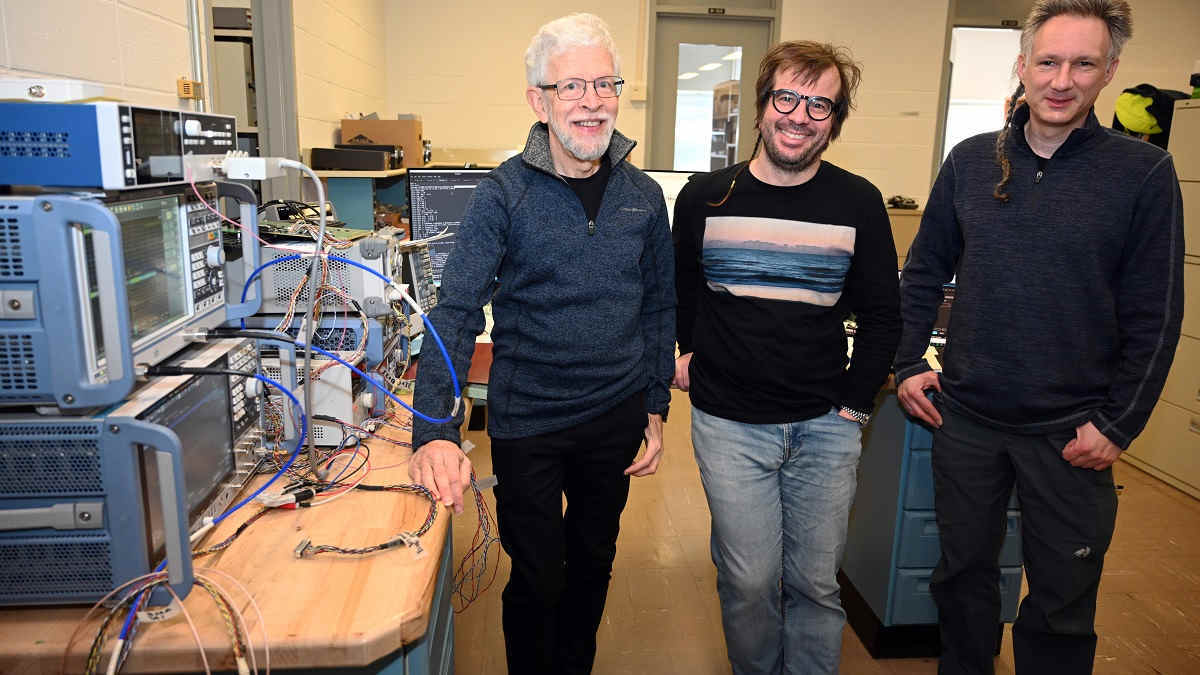
10.03.2023
Studying the Dark Ages could shed light on some of the biggest mysteries of nature.

Paul O'Connor, Anže Slosar, and Sven Herrmann (pictured left to right) are shown in the instrumentation lab at Brookhaven where the team is developing LuSEE-Night's spectrometer, the heart of the instrument. Credit: Brookhaven National Laboratory.
NASA and the US Department of Energy’s Brookhaven Laboratory are collaborating to land a telescope on the “dark side of the moon” in 2026.
If successful, the mission will mark the first step toward an understanding of the “Dark Ages” of the universe.
The Dark Ages are an era of cosmological history starting “only” 380,000 years after the Big Bang. The universe is approximately 13.8 billion years old, so the start of the cosmic Dark Ages occurred at a time when the universe was only 0.003 percent its current age.
No stars shone in the Dark Ages. As a result, cosmologists have never been able to observe this early part of the universe’s history.
“Modeling the universe is easier before stars have formed. We can calculate almost everything exactly,” says Brookhaven physicist Anže Slosar. “So far, we can only make predictions about earlier stages of the universe using a benchmark called the cosmic microwave background. The Dark Ages Signal would provide a new benchmark. And if predictions based on each benchmark don’t match, that means we’ve discovered new physics.”
However, ancient radio waves from the Dark Ages still linger in space. Studying them could shed light on some of the biggest mysteries of nature, such as how the universe itself was formed or understanding dark energy. The problem for astronomers is that radio signals here on Earth have masked the traces of the universe’s ancient past.
It’s for this reason that astronomers are looking to the Moon for a solution.
A new project called the Lunar Surface Electromagnetics Experiment-Night (LuSEE-Night) aims to access the Dark Ages Signal for the first time. LuSEE-Night will see a radio telescope make history as the first telescope to reach and survive on the lunar far side – the scientifically-correct term for what we know as the dark side of the moon.
This inhospitable environment isn’t actually perpetually dark, but there’s enough radio silence for the Dark Ages Signal to be detected.
The lunar far side is in total darkness for 14 Earth days followed by 14 days of brutal sunlight. Temperatures fluctuate between 121°C and -173°C within hours.
“The moon is easier to reach than Mars, but everything else is more challenging,” explains Brookhaven senior scientist Paul O’Connor. “There’s a reason only one robotic rover has landed on the Moon in the last 50 years, while six went to Mars, which is 100 times farther away.”
LuSEE-Night must reject heat in a vacuum environment during the day and keep itself from freezing at night. It needs to do this while powering itself through 14 days of continuous darkness and conducting first-of-its-kind science.
“LuSEE-Night is not a standard radio telescope,” Slosar says. “It’s more of a radio receiver. It will work like an FM radio, picking up radio signals in a similar frequency band. The spectrometer is at the heart of it. Like a radio tuner, it can separate out radiofrequencies, and it turns signals into spectra. That’s where our expertise gives us a starting point. Even though nobody has built an instrument like this before, we know how to build the most crucial component – a very sensitive spectrometer.”
After delivering the telescope, LuSEE-Night’s lander will power down completely so as not to produce any interference.
The telescope will extend its four three-metre long antennas. Then LuSEE-Night will have to survive the harsh vacuum environment on the lunar far side. An excruciating wait of 40 days will separate the telescope’s landing and the first dataset’s arrival on Earth via a relay satellite.
LuSEE-Night is designed to collect data for two years.
Quelle: COSMOS
690 Views
